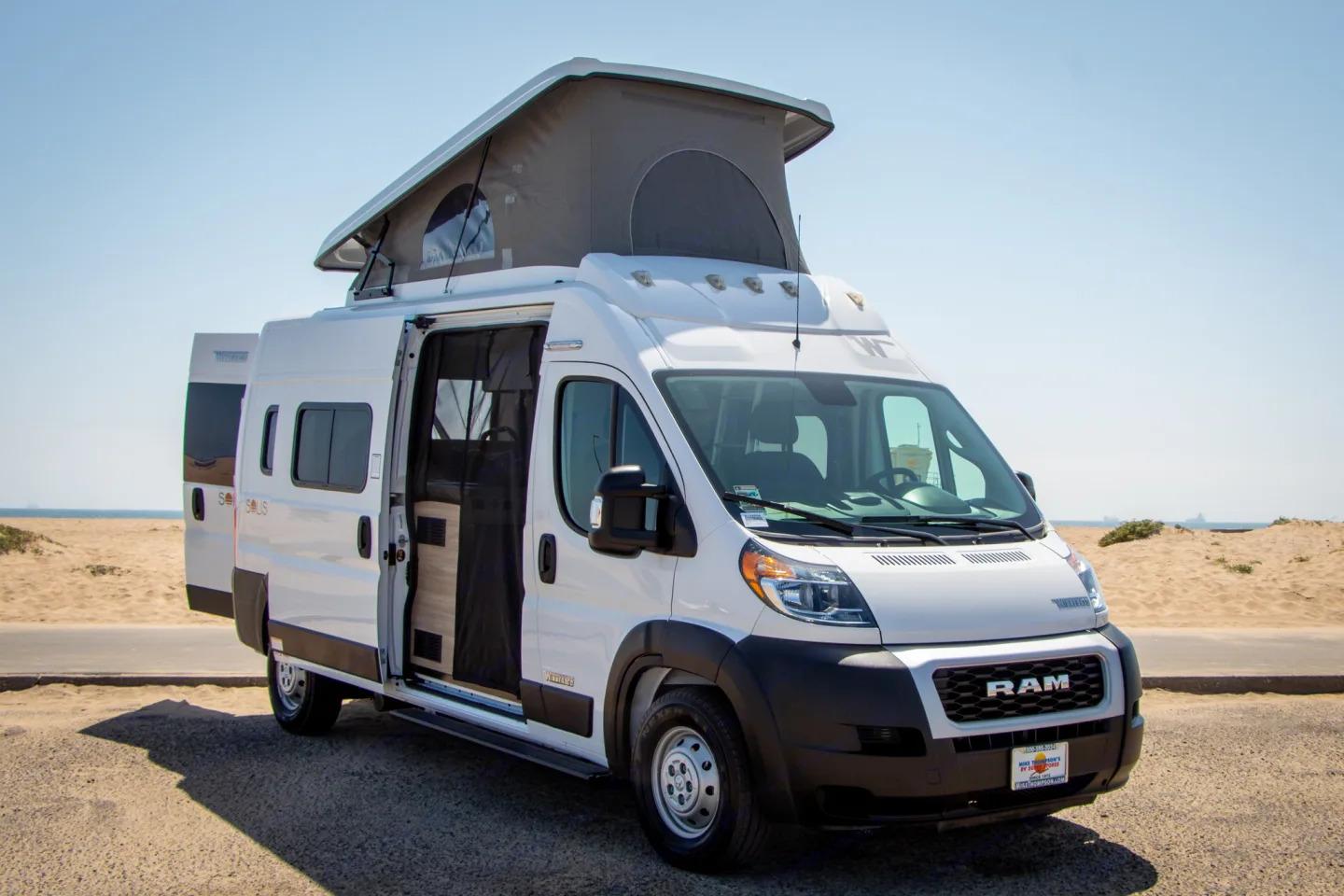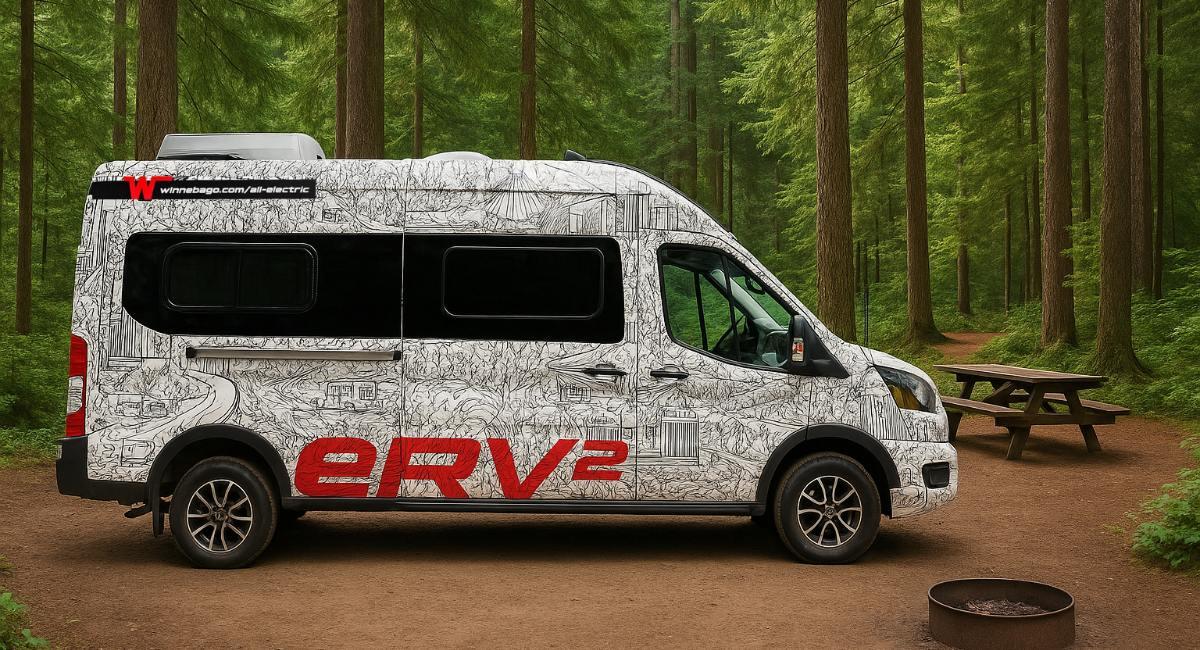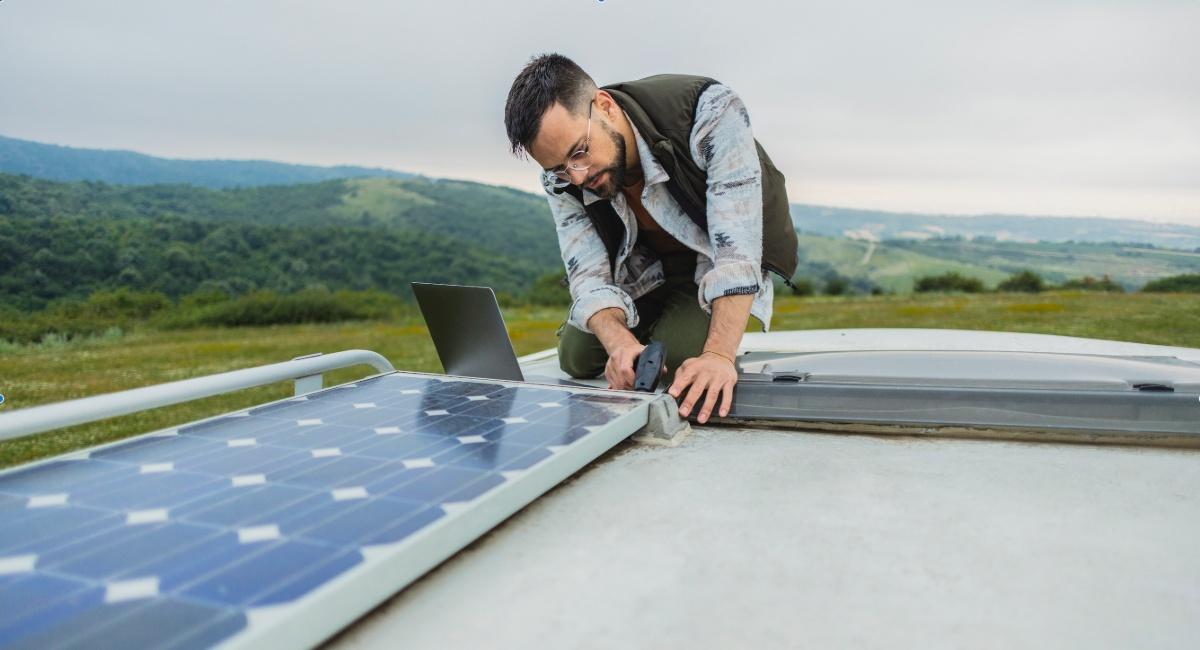Jan 25, 2023
Why We Love Winnebago's New All-Electric Campervan: The eRV2 Changes Everything
Why We Love Winnebago's New All-Electric Campervan: The eRV2 Changes Everything
Discover why we love Winnebago's new all-electric campervan. Learn about its innovative features, eco-friendly benefits, and why it's a game-changer for RVers.
Hit the road
Blog Post
Education

TL;DR: The Road Ahead is Electric
Winnebago's eRV2 isn't just another camper van—it's proof that zero-emission RV travel works. With up to 125 miles of range (manufacturers estimate), silent operation, and lower maintenance costs, this all-electric camper van delivers the freedom you want without the fuel costs you don't.
Built on Ford's E-Transit chassis with Winnebago's proven craftsmanship, the eRV2 makes sustainable van life accessible for weekend warriors and eco-conscious adventurers. Plus, with growing EV charging infrastructure and solar integration options, you can explore off-grid locations while keeping your environmental impact minimal.

What Makes the Winnebago eRV2 Different from Traditional Camper Vans?
The eRV2 runs completely silent, eliminates gas station stops, and costs significantly less to operate than gas-powered alternatives.
Look, we've all been there—trying to find a gas station in the middle of nowhere, or wincing at fuel costs that can eat up half your camping budget. The Winnebago eRV2 flips that script entirely.
Built on Ford's E-Transit platform, this isn’t some experimental prototype. It’s a real-world solution with up to 125 miles of estimated range. In practice, most users report around 108 miles per charge, making it ideal for weekend getaways and day trips. Range depends heavily on driving style, speed, terrain, and load, so actual range may vary. The electric drivetrain means you'll roll into camp without waking the neighbors (or the wildlife), and maintenance is about as simple as it gets.
Key Differences:
- Zero emissions: Clean conscience, cleaner campsites
- Silent operation: No generator noise, just nature sounds
- Lower operating costs: Electricity costs pennies compared to gas
- Instant torque: Electric motors deliver power immediately
- Simplified maintenance: No oil changes, fewer moving parts
Pricing, Availability, and Delivery: As of mid-2025, the Winnebago eRV2 starts between $150,000 and $165,000, depending on selected options. Fully equipped models may cost more, placing it firmly in the premium electric camper van category. After the prototype entered limited production in late 2023, availability has steadily increased, with broader deliveries rolling out through 2025. Customers currently face an estimated delivery window of 3 to 6 months after ordering.
How Does EV Charging Work for RV Travel?
Modern EV charging networks make electric RV travel increasingly practical, with DC fast charging adding 80+ miles in 30-45 minutes.
The charging game has changed dramatically in the past two years. What used to be a major concern for electric RV travel is now just another part of trip planning—like knowing where the good camping spots are. According to the U.S. Department of Energy's Alternative Fuels Data Center, there are now over 204,000 public charging ports nationwide as of 2024, representing more than double the infrastructure available since 2020.
The eRV2 works with standard CCS charging ports, which means you've got access to networks like Electrify America, ChargePoint, and EVgo. Most of these stations can add significant range in the time it takes to grab lunch and stretch your legs.
Charging Options:
- DC Fast Charging: 10-80% charge in 30-45 minutes at highway stops
- Level 2 Charging: Overnight charging at campgrounds (6-8 hours)
- Home Charging: Level 2 home setup for everyday use
- Solar Integration: Pair with portable solar panels for off-grid adventures
The Future of RV-Friendly Charging Stations: DC Fast Chargers (essential for electric RV travel), have expanded rapidly between 2022 and 2025. According to the International Energy Agency’s Global EV Outlook 2025, the number of U.S. fast charging connectors grew from around 40,000 in 2023 to over 50,000 in 2024, with similar ultra-fast charging expansion worldwide. Many of these are being installed along major highways, national travel corridors, and destinations relevant to road trip planning.
What Are the Real Benefits of Zero-Emission Camper Van Travel?
Electric RVs eliminate tailpipe emissions, reduce noise pollution, and often cost up to 60-70% less per mile to operate than gas alternatives.
Beyond the obvious environmental wins, electric camping just feels different. You'll appreciate the silence when you're trying to spot wildlife at dawn, or when you want to hear the river instead of your generator.
The financial benefits add up fast too. While electricity rates vary, most eRV2 owners report operating costs around 4-6 cents per mile versus 15-20 cents for comparable gas vans.
Environmental & Practical Benefits:
- Zero tailpipe emissions: Cleaner air at campsites and scenic areas
- Noise reduction: Silent operation preserves natural soundscapes
- Lower carbon footprint: Especially when charged with renewable energy
- Reduced maintenance: No oil changes, fewer fluids, simpler systems
- Energy independence: Solar charging reduces reliance on fossil fuels
Lifecycle Emissions: Studies show that electric RVs like the Winnebago eRV2 produce far fewer emissions over their lifetime compared to gas-powered models, even when you factor in battery production and electricity use. Most of their carbon footprint is offset within the first few years, and charging with renewables makes them even cleaner. The result is a significantly greener way to travel, without sacrificing comfort or capability.
How Do You Plan Off-Grid RV Travel with Electric Power?
Successful off-grid electric RV travel combines route planning with portable solar systems and efficient power management.
Off-grid electric RVing requires a different mindset than traditional camping, but it's absolutely doable. Think of it like planning any other specialized trip—you just need the right gear and a bit of strategy.
Solar panel systems have gotten incredibly efficient and affordable. A good 400-600 watt portable setup can extend your off-grid time significantly, especially when paired with the eRV2's efficient 12V systems.
Off-Grid Strategy:
- Solar power systems: 400-600W portable panels for extended boondocking
- Efficient appliances: LED lighting, 12V refrigeration, induction cooking
- Power monitoring: Real-time tracking of consumption vs. generation
- Route planning: Know your charging points and backup options
- Weather awareness: Solar production varies with conditions
Is RV Solar Energy Worth the Investment for Electric Camper Vans?

Solar systems pay for themselves within 2-3 years while enabling extended off-grid adventures that would be impossible with traditional RVs.
Here's the thing about solar on an electric RV—it's not just about saving money (though you will). It's about freedom. The ability to extend your stay at that perfect boondocking spot without worrying about your battery bank.
A well-designed solar setup can power your essential systems nearly indefinitely. While portable panels are not intended to recharge the driving battery fully, they extend your off-grid comfort substantially.
Solar Investment Benefits:
- Energy independence: Extended boondocking capability
- Cost savings: Free electricity after initial investment
- Environmental impact: 100% renewable energy source
- Quiet operation: No generator needed for basic power needs
- Property value: Increases resale value of your RV
Solar Panel Efficiency: In 2025, portable solar panels for RV use commonly achieve 22-24% efficiency, with compact setups delivering 400-600 watts ideal for extended off-grid stays. Costs have fallen to approximately $1.20-$1.50 per watt, improving affordability. Advances in foldable and flexible designs enhance portability without sacrificing output, making solar a practical energy solution for electric RV owners.
How Do You Make the Transition to an Electric RV?
The shift to electric RV travel is easier than most expect, but success comes down to proper planning and setting realistic expectations.
Early electric RV adopters consistently report that range anxiety diminishes quickly after the first few trips, and intentional travel planning often leads to discovering charming towns they never would have visited otherwise. Many find that EV charging stations become unexpected community hubs where like-minded travelers naturally connect.
Key Transition Insights:
- Start with shorter trips: Build confidence with familiar routes before attempting longer journeys
- Preconditioning is key: Warm or cool your RV while plugged in to preserve precious battery range
- Pack backup options: A small portable generator provides peace of mind for true emergencies
- Join electric RV communities: Online groups offer real-world charging station reviews and route recommendations
For travelers planning to live in their electric RV full-time, it's crucial to understand how full-time RV insurance differs from recreational coverage, as electric RVs have unique considerations for battery systems and charging equipment.
Like running out of gas, it requires planning to avoid. However, portable solar chargers and emergency charging services are becoming more available. Many eRV2 owners carry a backup portable generator for true emergencies.
The eRV2 has limited towing capacity due to range considerations. Check with Winnebago for current specifications, but expect reduced range when towing.
Charging costs vary by location and rates but typically range from $15-25 for a full DC fast charge and $8-12 for a home Level 2 overnight charge. That typically provides up to 125 miles of range per charge (manufacturer estimate), but around 108 miles is more typical in real-world driving.
Most RV insurance policies cover electric vehicles, but some insurers offer discounts for zero-emission RVs. The specialized battery systems may require specific coverage considerations. Understanding the different types of RV insurance plans available can help you choose the right protection for your electric setup.
Depending on the temperature, cold weather can reduce range by 15-25% or more, similar to how it affects phones and laptops. Pre-conditioning while plugged in helps, and proper insulation becomes even more important.
Roamly Insurance Group, LLC ("Roamly") is a licensed general agent for affiliated and non-affiliated insurance companies. Roamly is licensed as an agency in all states in which products are offered. Roamly license numbers. Availability and qualification for coverage, terms, rates, and discounts may vary by jurisdiction. We do not in any way imply that the materials on the site or products are available in jurisdictions in which we are not licensed to do business or that we are soliciting business in any such jurisdiction. Coverage under your insurance policy is subject to the terms and conditions of that policy and is ultimately the decision of the buyer.
Policies provided by Roamly are underwritten by Spinnaker Insurance Company, Progressive Insurance Company, Safeco Insurance Company, Foremost Insurance Company, National General Insurance, Mobilitas Insurance Company, and others.
© 2025 Roamly All rights reserved.
